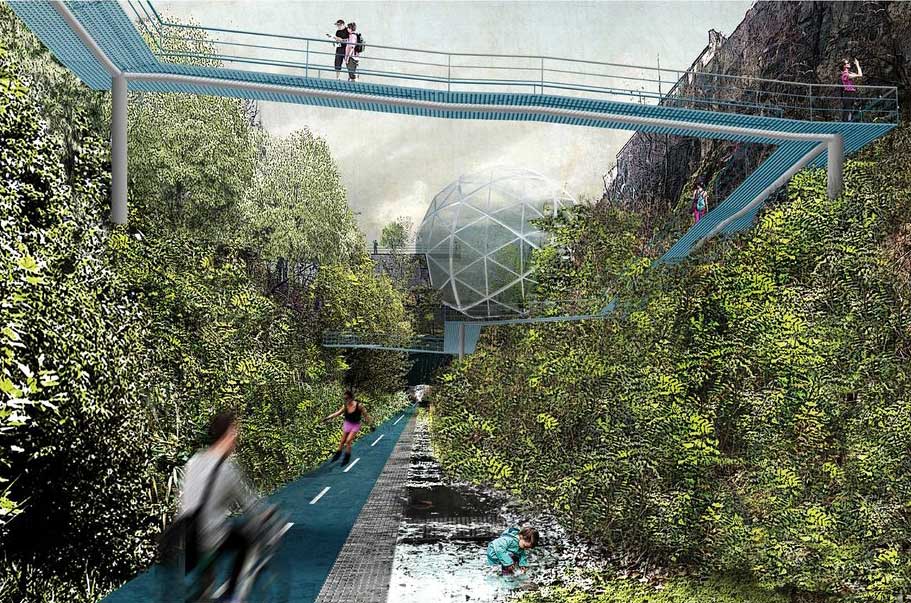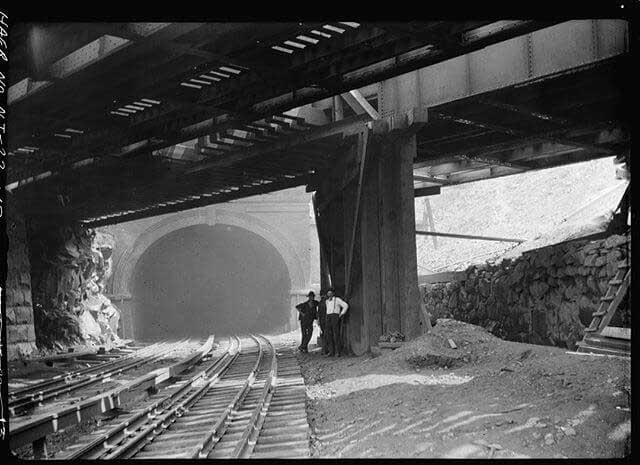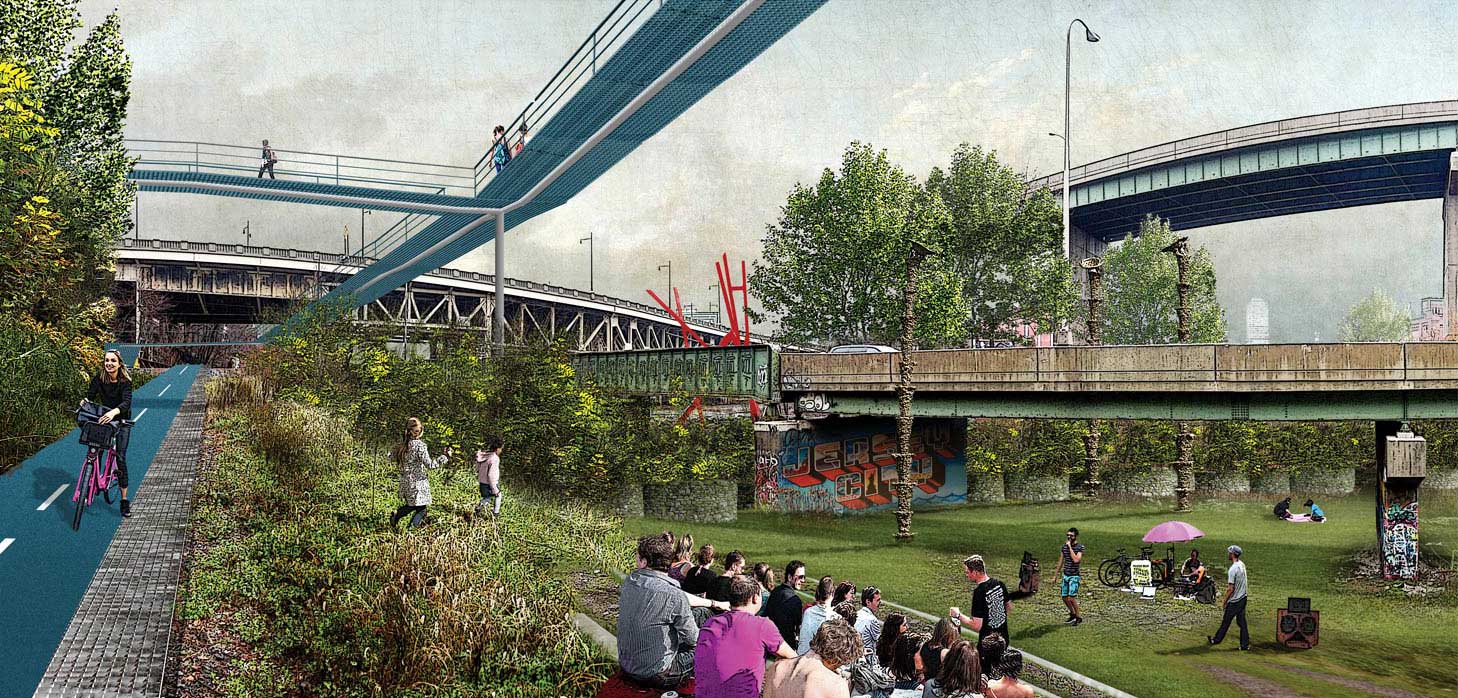
For all of its history, Jersey City has been a conduit for transport between NYC and the rest of the country. Over time, the logistics of transportation has changed. Once a major railroad hub, the city’s importance along the rail lines declined with the railroads themselves. When the trains stopped, rail tracks and tunnels were abandoned, left as artifacts of a bygone era of travel.
Most prominent of our rail transit days are the 10th Street and 6th Street embankments. The former, now home to a luxury rental community and the latter caught up in a decades long dispute over development rights. But a lesser known artifact sits just below the surface.
Long forgotten, The Bergen Arches are now the subject of a proposed community-based redevelopment project led by local residents and activists.

For those unfamiliar, the Bergen Arches is the common name for the Erie Railroad’s mile-long, four-track cut through the Palisades in Jersey City. It linked the railroad’s main line to the Hudson River waterfront and eventually Manhattan for its 30,000 daily passengers. The passage was finished in 1910, though since the last train in 1959, the Bergen Arches has become overlooked and almost completely forgotten.
Spearheaded by Jersey City-based place making organization Green Villain in collaboration with So + So Studio, a Berlin-based architecture firm, the group is presenting a vision for the redevelopment of The Bergen Arches. The hope is to continue to engage the general public, continue the conversation about urban land conservation and spark a movement that reactivates Jersey City’s backyard.

The plan itself “proposes site-specific landscape and architectural interventions to create a new public park and walkway, promote local artists and boost Jersey City’s overall cultural reputation.” The result is a public park where visitors can explore the cut via a series of paths and elevated walkways that meander through the vegetation canopies, sculpture gardens, murals and more.
We caught up with the team behind the proposal to learn more about the project. First we spoke with Bill Benzon of Green Villain:
Who are you and where do you live? How did you find out about the Bergen Arches/Erie Cut and what is your involvement with the project?
I’m Bill Benzon, independent scholar, writer, musician, photographer, activist. While I’m currently living in Hoboken, I’ve lived in Jersey City for most of the last 15 years or so, most of that time in Hamilton Park. While living in Hamilton Park I started photographing graffiti, but only as long as I could walk to it.
In July of 2007, I found my way into the Arches for the first time. I was stunned. Here I was in the middle of one of the most densely populated urban areas on the planet and I was lost to the world. Green all around, though trash was littered among the foliage, and fresh graffiti, “fresh” as in you could almost smell the paint and “fresh” as in wonderful. One thing led to another and a year later I’d put together a report, Jersey City: From a Skate Park to the World, in which I outlined an urban park that ran through Jersey City from the 6th Street Embankment, along Bergen Hill, and down into and through the Arches.
What is the most important feature of the Arches and why is it important to preserve it?
It’s one of the great engineering projects of the 20th century and it’s a very important part of Jersey City’s past. Jersey City used to be a major transportation center, but that’s changed when freight shipping moved to Port Newark because the water was deeper (to accommodate bigger ships). The whole Newport area of the city used to be woven with rail yards and railroad tracks. Now that’s all but disappeared and newcomers don’t realize what was here. It’s important to remember the past so that we can leave it behind, with respect, as we chart a new future.
What are your goals for the project?
To get the people of Jersey City to think deeply about the city and its future. For the Arches Project to happen it will require a large political effort that reaches every part of the city.
Cost aside, what do you envision being the focal point of this project?
Using sophisticated design to bring art and people down into this man-made, but now all-but-natural, marvel. Think about it, solid bedrock at the southern end of the Jersey Palisades, tons of dynamite and who knows how much blood, sweat, and toil, and you get the Erie Cut, almost a mile long. One railroad track (of four) remains, and it’s overgrown, green, and mostly deserted and forgotten. Now add 21st design sophistication and we’ve got a wonderful playground. It’s the mixture and melding off all that’s gone into the piece of land over, when you think about it, thousand of years.
—
We also spoke with Kevin Driscoll & Rion Philbin of So + So Studio, the architecture firm that designed the proposal.
Who are you and where do you live? How did you find out about the Bergen Arches/Erie Cut and what is your involvement with the project?
We are So + So, originally from the U.S. and currently working between Berlin, Germany and Genoa, Italy. We were introduced to the Bergen Arches by long time friends, Greg and Bill Benzon from Green Villain. They approached us with an idea to reintroduce the Bergen Arches to the public and have proven to be quite dedicated to the task since we started developing the project in October 2015.
What is the most important feature of the Arches and why is it important to preserve it?
We are consistently fascinated by the discovery of spaces that have for one reason or another been left alone long enough to almost disappear, completely back into nature. For such a large, once heavily trafficked space to lay still for so long, one gets this feeling of a beautiful opportunity. As if something once lost is now found and this something, that the rest of the world has been too busy to notice, is an opportunity to bring a piece of history back to life. We’ve been referring to the arches as “Jersey City’s backyard” and on a local scale, especially with all the development Jersey City’s seen in the last few years, it’s very clear why this is such an important space to fight for. It’s a place for residents and local kids, artists and even people looking to get out of the city for the day. It’s the beginning of a very bright and creative future for Jersey City.
What are your goals for the project?
The first goal for the project is to connect a wide range of neighborhoods with two new Cuts through the existing vegetation and unused infrastructure. This would include a way in which the public can access the Bergen Arches through a series of elevated paths and walkways that converse with the surrounding landscape and overgrown history, sometimes descending as low as 60 feet below the street.
Cost aside, what do you envision being the focal point of this project?
The Bergen Arches is too dynamic of a space to reduce to one focal point or one moment. Instead, there are a series of interventions throughout the length of the mile long Bergen Arches. Various elevated paths will guide you through the space, following the old train line or meandering up and down through the trees and tunnels. Viewing platforms will rise above the tree canopies, allowing access to the space and views of the surroundings. In the end, we want to provide the people of Jersey City with these spaces in which they can make their own and add their own emphasis to.

With Jersey City’s residential boom well underway, it’s time to start thinking about what will make Jersey City a world-class destination where people want to live and tourists want to visit. The team behind the project said it best:
“As our post-industrial city continues to amass mid to high-rise towers, it is imperative that we look down as much as we look up for the answers about individuality and place. The stick and steel will allow the residents to live here, Restaurant Row to eat here, but without Jersey City-centric projects that allow us to compete on the global stage we will always be haunted by the specter of placelessness. The Bergen Arches project is the answer. Help us to reclaim and revitalize these spaces that bear such history and call for a creative future for Jersey City.”
To learn more about the project visit, The Bergen Arches website and follow along on Instagram.
What do you think? Should Jersey City transform the Bergen Arches into a hub of history, art, and open space? Let us know in the comments.